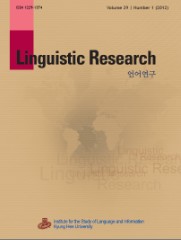
Native listeners' perceptual assessments of native and foreign-accented speech and their associations with various speech properties
Native listeners' perceptual assessments of native and foreign-accented speech and their associations with various speech properties
- 경희대학교 언어정보연구소
- 언어연구
- 제41권 제1호
- 2024.03
- 27 - 63 (37 pages)
When native listeners assess various aspects of both native and non-native speech, do they rely on similar or different speech properties? We investigated this question by conducting two rating tasks with relatively short, spontaneous utterances produced by ten American-English native speakers (L1 speech stimuli) and 21 Korean native speakers (L2 speech stimuli). Fifty-four native English raters evaluated perceptual aspects such as accentedness, fluency, comprehensibility, and pleasantness of either L1 or L2 speech stimuli. The speech stimuli were coded for the twelve speech properties categorized as speed, lexical richness, rhythm, voice quality, and repair fluency. Analyses included correlation and mixed-effects models that allowed to examine the relationships between rated perceptual dimensions and the relative impact of speech properties on L1 and L2 speech evaluations. The findings indicated more robust and stronger relationships among the perceptual dimensions in the L2 rating task compared to the L1 rating task, suggesting that raters are better able to distinguish multiple perceptual dimensions of more familiar speech (L1) as opposed to less familiar speech (L2). Moreover, mixed-effects model analyses revealed that raters assigned the distinct weights to different linguistic features, albeit with some overlap, depending on the type of speech being evaluated. This empirical evidence underscores the possibility that listeners may assess native and non-native speech utterances in different manners.
1. Introduction
2. The current study
3. Method
4. Results
5. Summary
6. General discussion
7. Conclusion
References